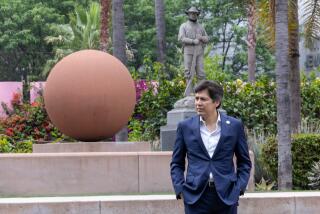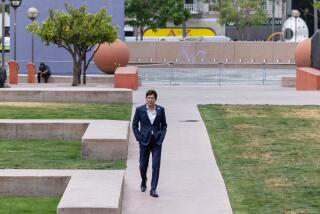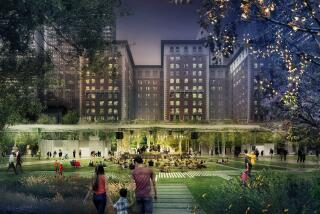Op-Ed: A monument to California’s Black history — and a great work of art — may soon be destroyed
As antiracist activists topple statues of slaveholders across the country, UC San Francisco threatens to demolish a very different kind of monument: a mural depicting a celebrated former slave.
The work shows Biddy Mason, an African American midwife who rose to fortune in Los Angeles after winning her freedom in the mid-1850s. Since the Great Depression, the mural has been displayed alongside nine others in UC Hall on the university’s main campus. But now the building and its artwork are slated for demolition to make way for new office, medical and research space.
In the mid-1930s, UC San Francisco commissioned the Polish-born artist Bernard Zakheim to paint a set of murals of California’s medical history. Zakheim, who studied with Diego Rivera, had become regarded as one of the state’s major artistic figures. Like his murals in San Francisco’s Coit Tower, his UC San Francisco works are landmarks in the bold, modern style of the New Deal era. They have been hailed as “the jewel of the University’s art collection.”
The panel featuring Biddy Mason is perhaps the most historically significant of the 10 murals. In it, Mason tends to a malaria patient alongside Dr. John Griffin, one of Los Angeles’ preeminent early medical authorities. Below, other patients await treatment from Griffin and Mason, who formed a renowned medical partnership in mid-19th century Los Angeles.
What makes the mural unique is its composition. Mason occupies center stage. She’s surrounded by a group of white men — soldiers, patients, doctors, city officials — but she’s not subordinate to them. Rather, she tends to the patient directly as a medical authority in her own right. Zakheim depicts Mason as she was: a healing presence and a pillar of early Los Angeles.
Biddy Mason began her days in radically different circumstances. Born into slavery in the Georgia cotton belt in 1818, she was seemingly destined for a life of hard labor and a death in obscurity. Like other enslaved African Americans, she lacked a legal family name. She was simply Bridget, or Biddy.
In the late 1840s, Biddy began a long, strange trip — one that took her out of the South and across the continent. She went as a slave, forcibly transported by her master, along with several other Black women and children. They arrived first in Utah before moving to a small Mormon colony in San Bernardino, Calif., in 1851.
Although California was technically a free state, authorities turned a blind eye to slaveholding settlers in their midst. Several dozen slaves worked in San Bernardino alone. Only in 1856 — six years after California outlawed human bondage — did Biddy, along with 13 other African American women and children, win their freedom in a Los Angeles courtroom.
Once free, Biddy took the last name Mason and began an improbable rise through the social ranks of early Los Angeles. She used money earned as Dr. Griffin’s assistant to invest in real estate, just as L.A. was beginning to boom. Although illiterate and subject to both racial and gender discrimination, Mason amassed a tremendous fortune. Some estimates place her total wealth at $300,000 (equivalent to $8.5 million today).
Mason is remembered not only for her uncanny business acumen, but also for her philanthropy. She gave liberally — of her time, money and medical expertise — to those in need around Los Angeles. She also co-founded the first African American house of worship in the city. First African Methodist Episcopal Church remains a mainstay of L.A.’s Black community to this day.
Now, a piece of Mason’s legacy — the oldest known artistic representation of the famous freedwoman — faces demolition.
University spokespeople claim that UC San Francisco is unable to cover the costs of removing and preserving the murals, estimated at $8 million. If the price of saving 10 frescoes is prohibitive, one wonders where the university will find the funds for its proposed 1.5 million-square-foot expansion project. Perhaps the university could start by dipping into its nearly $4-billion endowment.
Local residents have already begun to protest the development project, set to break ground in 2023. They argue that the expansion will add thousands of workers to the Parnassus Heights campus, further straining the community’s overtaxed transit systems and housing options. Critics can add the university’s destruction of history to their list of grievances.
The artist’s son, Nathan Zakheim, has been given three months to propose a plan to remove the murals at the family’s expense. After that, the university will solicit proposals from the public to adopt the murals — again without financial support from UC San Francisco. If no one comes forward: demolition.
UC San Francisco proposes a Silicon Valley solution: a digital re-creation of the murals, which would later be featured in a virtual reality display. Through goggles, visitors would get a secondhand look at art destroyed by the university.
The timing could not be worse. During a crossroads in race relations, when Black American voices are finding new purchase, the university threatens an important piece of Black women’s history.
The United States boasts vanishingly few monuments to women of color. Fewer still if the university is allowed to go forward with its ill-considered plans to bulldoze the Biddy Mason mural along with nine others. Black Lives Matter. And so does Black history.
Jackie Broxton is the executive director of the Biddy Mason Charitable Foundation, which provides services and support to L.A.’s foster youth population. Kevin Waite is an assistant professor of history at Durham University and co-director of an National Endowment for the Humanities-funded project on the life and times of Biddy Mason.
More to Read
A cure for the common opinion
Get thought-provoking perspectives with our weekly newsletter.
You may occasionally receive promotional content from the Los Angeles Times.










